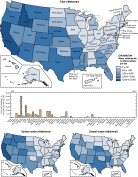
 |
Estimated Use of Water in the United States in 2000
Irrigation
Irrigation withdrawals and irrigated acres by irrigation system are listed by State in table 7. ![]() For 2000, withdrawals were an estimated 137,000 Mgal/d, or 153,000 thousand acre-feet per year. Irrigation withdrawals were 40 percent of total freshwater withdrawals and 65 percent of total freshwater withdrawals for all categories excluding thermoelectric power. Surface water accounted for 58 percent of the total irrigation withdrawals. About 61,900 thousand acres were irrigated in 2000. Of this total acreage, about 29,400 thousand acres were irrigated with surface (flood) systems; 28,300 thousand acres with sprinkler systems; and 4,180 thousand acres with microirrigation systems. Application rates were calculated by dividing total withdrawals by irrigated acres. The average application rate was 2.48 acre-feet per acre for the United States.
For 2000, withdrawals were an estimated 137,000 Mgal/d, or 153,000 thousand acre-feet per year. Irrigation withdrawals were 40 percent of total freshwater withdrawals and 65 percent of total freshwater withdrawals for all categories excluding thermoelectric power. Surface water accounted for 58 percent of the total irrigation withdrawals. About 61,900 thousand acres were irrigated in 2000. Of this total acreage, about 29,400 thousand acres were irrigated with surface (flood) systems; 28,300 thousand acres with sprinkler systems; and 4,180 thousand acres with microirrigation systems. Application rates were calculated by dividing total withdrawals by irrigated acres. The average application rate was 2.48 acre-feet per acre for the United States.
The geographic distribution of total, surface-water, and ground-water withdrawals for irrigation is shown in figure 7.  The majority of withdrawals (86 percent) and irrigated acres (75 percent) were in the 17 conterminous western States. Irrigated acreage in these States were located in areas where average annual precipitation typically is less than 20 inches and is insufficient to support crops without supplemental water. Surface water was the primary source of water in the arid West and the Mountain States. Ground water was the primary source of water in the Central States. California, Idaho, Colorado, and Nebraska combined accounted for one-half of the total irrigation withdrawals. California and Idaho accounted for 40 percent of surface-water withdrawals. California and Nebraska accounted for one-third of ground-water withdrawals.
The majority of withdrawals (86 percent) and irrigated acres (75 percent) were in the 17 conterminous western States. Irrigated acreage in these States were located in areas where average annual precipitation typically is less than 20 inches and is insufficient to support crops without supplemental water. Surface water was the primary source of water in the arid West and the Mountain States. Ground water was the primary source of water in the Central States. California, Idaho, Colorado, and Nebraska combined accounted for one-half of the total irrigation withdrawals. California and Idaho accounted for 40 percent of surface-water withdrawals. California and Nebraska accounted for one-third of ground-water withdrawals.
California, Nebraska, Texas, Arkansas, and Idaho accounted for 53 percent of total irrigated acreage. California, Nebraska, and Texas accounted for 40 percent of the irrigated acreage using sprinkler and microirrigation systems. California alone accounted for 72 percent of the irrigated acreage by microirrigation systems. Sprinkler and microirrigation systems were associated with slightly more than 50 percent of total irrigated acreage.
Application rates were greatest in the arid West and the Mountain States where surface water was available and surface (flood) application was the predominant method of irrigation. In Arizona, Montana, and Idaho, application rates exceeded 5 acre-feet per acre. States that utilized the High Plains aquifer (Nebraska, Texas, Kansas, and Oklahoma) or the Mississippi River alluvium (Arkansas, Missouri, Mississippi, and Louisiana) for irrigation relied mostly on ground water and had application rates ranging between 1 and 2 acre-feet per acre. Sprinkler irrigation was the predominant application method in the Central Plains States of Kansas, Nebraska, North Dakota, Oklahoma, South Dakota, and Texas. Surface irrigation was the predominant application method in Arkansas, Louisiana, Mississippi, and Missouri.
Estimates of total irrigation withdrawals for 2000 were about 2 percent more than during 1995. Surface-water withdrawals were about 5 percent less for 2000 compared to 1995, but ground-water withdrawals were 16 percent more. The estimated number of irrigated acres was about 7 percent more, which resulted in a slightly lower average application rate for 2000. The number of acres irrigated for 2000 using sprinkler or microirrigation systems was 25 percent more than during 1995.
Sources of data for irrigation withdrawals and irrigated acres included State and Federal crop reporting programs. Withdrawals also were estimated using information on irrigated crop acreages along with specific crop water-consumption coefficients or irrigation-system application rates. Estimation methods varied from one geographic area to another. Estimation methods ideally included adjustments for climatic variables, system efficiencies, conveyance losses, and other irrigation practices such as pre-irrigation. Other methods of estimating irrigation withdrawals included extrapolation of sample data on crop water-application rates or power-consumption coefficients.
Water Use in the United States | USGS Water Resources of the United States
For more information: wu-info@usgs.gov